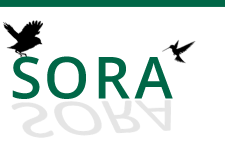Abstract
Con el propósito de realizar un seguimiento a largo plazo de las poblaciones de aves acuáticas en Venezuela, la Unión Venezolana de Ornitólogos (UVO) realiza anualmente y de forma consecutiva el Censo Neotropical de Aves Acuáticas de Venezuela (CNAAV) desde hace ocho años. En este artículo se presentan los resultados del CNAAV 2013. Como en años anteriores se hicieron dos conteos, uno en febrero y otro en julio, con la participación de 26 censistas voluntarios (20 en febrero, nueve en julio). Se censó en seis estados para un total de 26 localidades censadas (21 en febrero, 20 en julio). Se cuantificaron 65 especies (60 en febrero, 60 en julio). De las especies censadas, 19 fueron migratorias Neárticas (19 en febrero, 16 en julio), 39 residentes (35 en febrero, 36 en julio) y ocho residentes con poblaciones que migran hacia la región Neártica (seis en febrero, cinco en julio). Se realizaron 823.053 avistamientos (412.204 en febrero, 410.849 en julio). Las aves migratorias Neárticas fueron más abundantes en febrero, donde se realizaron 4.864 avistamientos, mientras que en julio solo 203. Las especies migratorias Neárticas más abundante fueron el Barraquete Aliazul Anas discors y el Playerito Occidental Calidris mauri, seguidas del Tigüi-Tigüe Grande Tringa melanoleuca y la Becasina Migratoria Limnodromus griseus. Por su parte, las especies residentes más abundantes fueron la Cotúa Olivacea Phalacrocorax brasilianus y el Flamenco Phoenicopterus ruber.
In order to carry out a long-term monitoring of waterbird populations in Venezuela, the Venezuelan Ornithologists’ Union (UVO) have conducted the Neotropical Waterbird Census in Venezuela (CNAAV) annually and consecutively the for the last eight years. Here, we present the results of CNAAV 2013. As in previous years, there were two bird counts, one in February and other in July, with a total participation of 26 surveyors (20 in February, nine in July). Surveys were conducted in six states and 26 locations (21 in February, 20 in July). Sixty five species were recorded in both counts (60 in February, 60 in July), 19 of which were Neartic migrant (19 in February, 16 in July), 39 were resident species (35 in February, 36 in July) and eight were residents with populations that migrate from the Nearctic region (six in February, five in July). Overall, 823,053 individuals were recorded (412,204 in February; 410,849 in July). Nearctic migrants were more abundant in February with 4,864 records, while only 203 were recorded in July. The most abundant Nearctic migrants were the Blue-winged Teal Anas discors and the Western Sandpiper Calidris mauri, followed by the Greater Yellowlegs Tringa melanoleuca and the Shortbilled Dowitcher Limnodromus griseus. The Neotropic Cormorant Phalacrocorax brasilianus and the American Flamingo Phoenicopterus ruber were the most abundant resident species.
Creative Commons License
Recommended Citation
Sainz-Borgo, Cristina; García, Daniel; López, Eduardo; Espinoza, Frank; Yáñez, Génesis; Torres, Lermith; Martínez, Margarita; Hernández, Marieta; Caula, Sabina; Sanz, Virginia; and Giner, Sandra
(2014)
"Censo Neotropical de Aves Acuáticas en Venezuela 2013 / Neotropical Waterbird Census in Venezuela 2013,"
Revista Venezolana de Ornitología: Vol. 4
:
Iss.
1
, Article 2.
Available at:
https://digitalcommons.usf.edu/rvo/vol4/iss1/2

